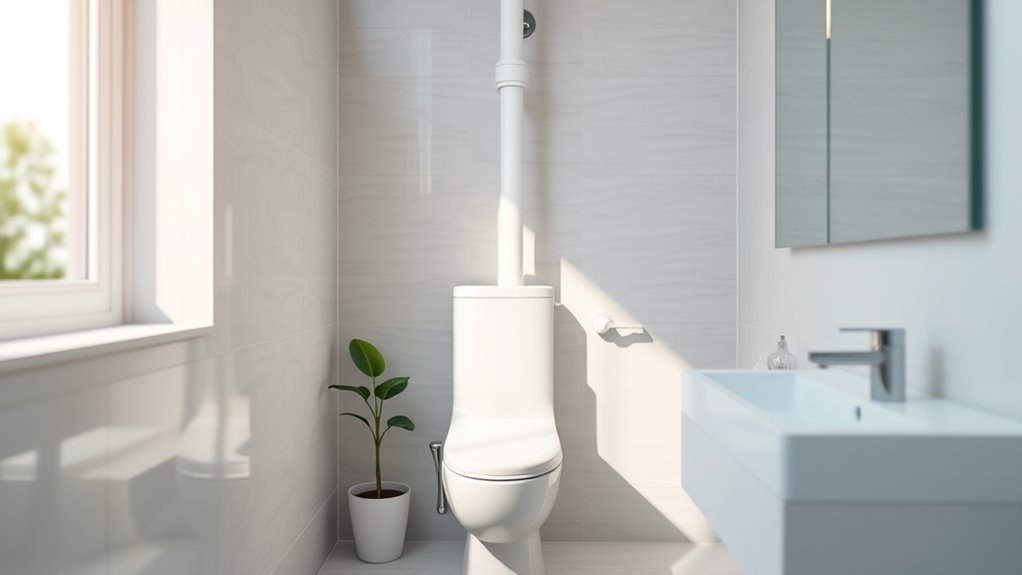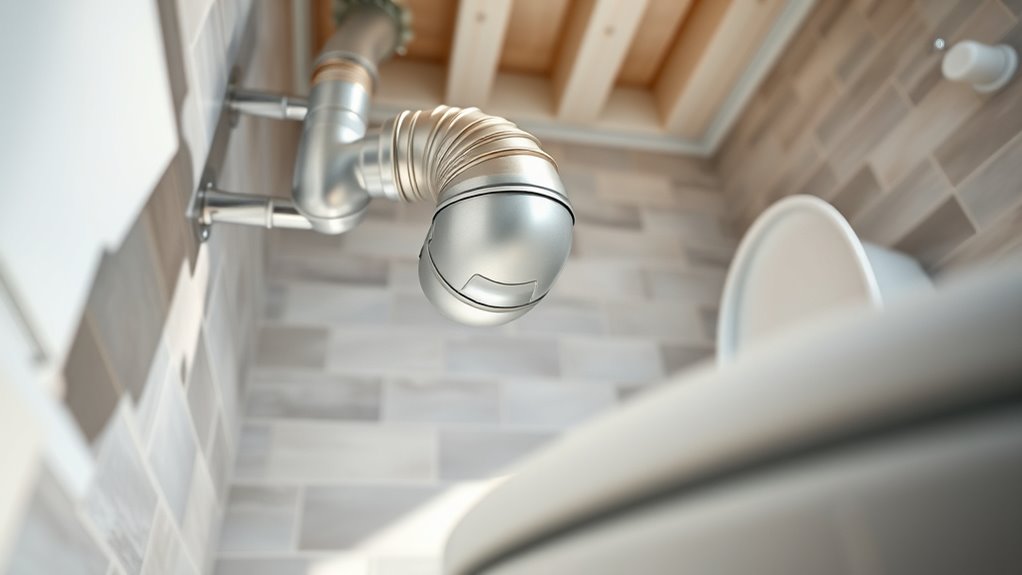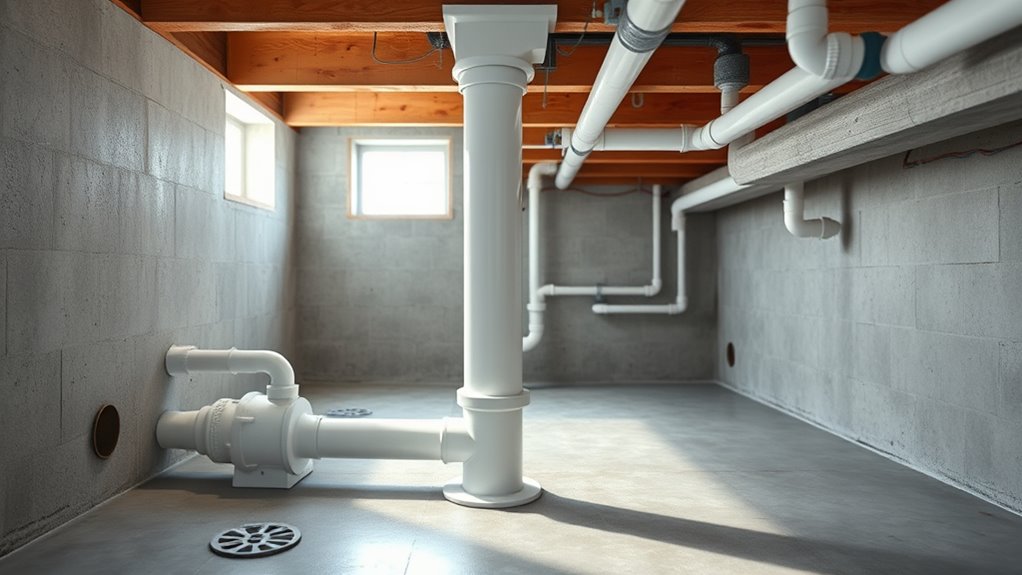Where Is the Toilet Vent Pipe Located? How to Find and Identify Vent Pipes
Toilet vent pipes are usually found on the roof and within the walls close to bathrooms and kitchens. They are essential for proper air circulation in the plumbing system. To locate them, look for vertical stacks in multi-story homes or trace the plumbing lines from your bathroom. Tools like a stud finder or inspection camera can assist in pinpointing their exact location.
Understanding Toilet Vent Pipes

Toilet vent pipes are crucial for effective plumbing, ensuring proper drainage and preventing sewer gases from entering your home. These vertical pipes connect to the toilet’s drainage system, allowing air circulation that maintains pressure balance. This setup ensures smooth water flow during flushing and helps prevent blockages.
Typically extending through the roof, it’s important that vent pipes are correctly sized and installed. They run parallel to waste pipes, creating a pathway for gases to escape.
Understanding the role and placement of toilet vent pipes is essential for a healthy plumbing system, as improper installation or blockages can lead to unpleasant odors and drainage problems.
If you’re experiencing issues like slow drainage or bad smells, it might be time to check your toilet vent pipes for proper function.
Importance of Ventilation in Plumbing
Proper ventilation in plumbing systems is crucial for ensuring safety and functionality.
It prevents harmful sewer gases from accumulating, which can pose serious health risks.
Additionally, effective ventilation helps maintain smooth drainage, minimizing the chances of clogs and backups.
Understanding the importance of ventilation is key to keeping your plumbing system safe and efficient.
Preventing Sewer Gas Accumulation
To prevent sewer gas accumulation in your home, it’s essential to have a properly designed plumbing system with effective ventilation.
Vent pipes allow sewer gases to escape safely, preventing them from entering living spaces. If your venting is blocked or insufficient, it can lead to unpleasant odors and potential health risks.
Regularly inspect and maintain your vent pipes to ensure they remain clear and functional.
Be alert to signs of plumbing issues, such as slow drains or unusual smells, as these may indicate ventilation problems.
Prioritizing proper ventilation is crucial for maintaining a safe and healthy indoor environment.
Ensuring Proper Drainage Flow
Effective drainage flow is crucial for any plumbing system, and it largely depends on a properly functioning ventilation system. Vent pipes are essential as they allow air to enter the drainage system, equalizing pressure and preventing vacuum formation.
Without sufficient ventilation, you may experience sluggish drainage or backups, which can lead to clogs and expensive repairs.
To ensure smooth wastewater flow and minimize obstruction risks, it’s vital to have vent pipes installed correctly. They also play a role in maintaining the system’s health by preventing siphoning, which can allow sewer gases to escape into your home.
Regular inspection and maintenance of vent pipes are necessary to ensure optimal drainage performance in your plumbing system.
Common Locations for Vent Pipes
Common locations for vent pipes in residential plumbing include:
- Roof: Vent pipes are typically installed on the roof to safely disperse gases away from the home.
- Walls: Often found near bathrooms and kitchens, these vent pipes connect to the drainage system.
- Vertical Stacks: In multi-story homes, vertical stacks function as both waste and vent pipes, running through the center of the house.
- Basements: Vent pipes may also be present in basements, especially where plumbing fixtures are located on lower levels.
Understanding these locations helps homeowners and professionals maintain efficient plumbing systems.
How Vent Pipes Function

Vent pipes are crucial for the proper functioning of your plumbing system. They allow air to enter the drainage system, preventing vacuum formation that can disrupt water flow. This ensures wastewater moves freely and helps equalize pressure within the system, enhancing efficiency.
Additionally, vent pipes safely release sewer gases outside your home, protecting you from harmful fumes and odors. To maintain a healthy plumbing system and reduce the risk of clogs and backups, regular maintenance of vent pipes is essential.
Identifying Vent Pipes in Your Home
Identifying vent pipes in your home is essential for ensuring proper plumbing ventilation. Here’s how to locate them:
1. Location: Vent pipes typically extend vertically from the roof, allowing air and gases to escape.
Inside, they often run parallel to drainpipes within walls or behind cabinetry.
2. Characteristics: Look for vertical pipes that may be hidden behind drywall or in attics.
Vent pipes are usually made of PVC or metal and often have a larger diameter than standard plumbing pipes.
3. Appearance: They may be painted in a color that distinguishes them from other pipes, making them easier to identify.
Tools Needed for Locating Vent Pipes
To effectively locate vent pipes in your home, having the right tools is essential.
Here are three key tools that will help you find vent pipes efficiently:
- Stud Finder: This device helps you detect pipes behind walls without causing damage, ensuring you pinpoint their location accurately.
- Inspection Camera: Use this tool for a visual inspection of areas that are hard to reach. It allows you to see inside walls or ceilings where vent pipes may be situated.
- Measuring Tape: This is crucial for measuring distances and angles, helping you accurately map out the layout of your vent pipes.
Using these tools will make the process of locating vent pipes quicker and easier, enhancing your plumbing maintenance efforts.
Inspecting the Roof for Vent Pipe Access
To inspect your roof for vent pipe access, follow these steps:
1. Gather Your Tools: Ensure you have the necessary tools ready for the inspection.
2. Look for Vent Pipes: Search for cylindrical pipes extending above the roofline, typically made of PVC or cast iron.
They are often located near bathrooms, as they allow sewer gases to escape.
3. Check for Damage: Inspect the pipes for any signs of rust or cracks, which can indicate potential issues.
4. Prioritize Safety: Always wear appropriate safety gear and ensure your footing is stable while on the roof to prevent accidents.
This focused approach will help you efficiently assess your roof’s vent pipe access and condition.
Checking Walls and Ceilings for Vent Pipes
To effectively locate vent pipes within walls and ceilings, homeowners can use the following methods:
- Listen for Sounds: Gurgling noises during drainage can indicate nearby vent pipes.
- Inspect for Access Panels: Look for any access panels in walls that may lead to hidden plumbing systems.
- Use a Stud Finder: A stud finder can help reveal the layout of walls and detect metallic vent pipes.
These techniques will assist you in pinpointing the location of vent pipes in your home.
Evaluating the Basement or Crawl Space

When inspecting your basement or crawl space, it’s crucial to thoroughly examine the pipe layout.
This inspection is key to locating vent pipes, which are essential for effective toilet ventilation.
Understanding the current setup will help you make informed choices regarding any needed adjustments or installations.
Inspecting Pipe Layout
Inspecting the pipe layout in your basement or crawl space is crucial for maintaining proper ventilation and drainage in your plumbing system.
Here are the key areas to focus on during your inspection:
- Pipe Configuration: Ensure that pipes are arranged without obstructions that could block airflow or drainage.
- Material Integrity: Look for signs of corrosion or damage, as these can lead to leaks and system failures.
- Slope and Alignment: Verify that pipes are correctly sloped to facilitate effective drainage, preventing water from pooling or backing up.
Regular inspections can help you identify and address potential issues before they become major problems.
Identifying Vent Location
To find the vent location in your basement or crawl space, start by inspecting the plumbing layout.
Look for visible pipes; vent pipes often run vertically alongside drain lines. Check the junctions where different plumbing systems connect, as this is where vent pipes usually appear.
Signs of moisture or mold may indicate poor ventilation. Use a flashlight to illuminate dark areas and measure the distance from the main sewer line to help locate the vent.
Combining visual checks with strategic measurements will lead you to the vent pipe efficiently.
Understanding Local Building Codes
Understanding local building codes is crucial for anyone working on construction or renovation projects involving plumbing systems, especially toilet vent pipes. Adhering to these codes ensures safety, efficiency, and legal compliance.
Here are the key aspects to consider:
- Vent Pipe Sizing: Make sure to follow specifications for diameter and length to ensure proper airflow.
- Placement Requirements: Install vent pipes according to guidelines to prevent odors and ensure functionality.
- Material Regulations: Use approved materials for vent pipes that can withstand environmental factors and ensure durability.
What to Do If You Can’t Find the Vent Pipe
If you can’t find the vent pipe, start by checking your roof for any visible signs.
Review your plumbing blueprints for the system’s layout.
A stud finder can also help locate hidden pipes within your walls.
These steps will guide you in identifying the vent pipe efficiently.
Inspecting the Roof
How to Locate the Vent Pipe on Your Roof
If you’re having trouble finding the vent pipe on your roof, follow these effective strategies:
- Use a flashlight: This will help you see into dark areas and spot hidden pipes.
- Check for roof penetrations: Look for any protrusions or caps that could indicate a vent pipe’s location.
- Trace plumbing lines: Follow the plumbing from bathrooms or kitchens to help pinpoint where the vent pipe might be situated.
These methods will assist you in successfully identifying the vent pipe on your roof.
Check Plumbing Blueprints
If you can’t find the vent pipe on your roof, checking the plumbing blueprints can help.
These blueprints show the plumbing system layout, including the vent pipe locations. Look for symbols and lines that indicate plumbing fixtures and venting systems. They also provide information on the vertical rise of the vent pipes, which can guide you to their position inside your home.
Ensure the blueprints are current, as any renovations might have changed the plumbing layout. This approach can help you efficiently locate the vent pipe.
Use a Stud Finder
To locate a hidden vent pipe, using a stud finder is an effective method. Here’s how to do it:
- Scan the Wall: Move the stud finder horizontally and vertically along the suspected area of the vent pipe. Look for changes in wall density, which indicate plumbing pipes.
- Adjust Sensitivity: If your stud finder has sensitivity settings, increase it to enhance detection capabilities for hidden pipes.
- Expand Your Search: If you don’t find the vent pipe in one area, broaden your scanning area.
- Consult a Professional: If you still can’t locate the pipe, consider reaching out to a plumber for expert assistance.
Using these tips will help you efficiently locate hidden vent pipes in your home.
Signs of Vent Pipe Blockage
When a vent pipe is blocked, homeowners may notice several key signs.
Watch for slow drainage in sinks, showers, or toilets, which indicates restricted airflow in the plumbing system.
Gurgling sounds from fixtures are another warning sign, as trapped air attempts to escape.
Foul odors from drains may suggest stagnant water due to poor ventilation.
Increased pest activity, such as flies, can also indicate a blockage from waste buildup.
If multiple fixtures back up simultaneously, it signals a serious vent pipe blockage that needs immediate attention.
Recognizing these signs early can help you avoid further plumbing problems.
Troubleshooting Vent Pipe Issues
If you’re experiencing slow drainage, gurgling noises, or unpleasant odors in your home, these could be signs of vent pipe issues.
Here’s how to troubleshoot and resolve them:
- Check for Blockages: Inspect the vent pipe for any debris, leaves, or animal nests that might obstruct airflow. Clear any obstructions you find.
- Evaluate Pipe Condition: Look for corrosion, cracks, or loose connections in the vent pipe. Any damage could hinder its functionality and may need repair or replacement.
- Ensure Proper Slope: Verify that the vent pipe is correctly sloped to facilitate effective drainage and ventilation. A misaligned pipe can contribute to drainage problems.
When to Call a Professional Plumber
Homeowners should seek professional plumbing assistance when they notice specific signs of plumbing issues.
Key indicators include persistent slow drainage, gurgling sounds from drains, or frequent clogs that don’t improve with basic remedies. These symptoms may signal deeper problems within the plumbing system.
Additionally, foul odors from pipes or visible water damage around fixtures warrant immediate attention.
Structural changes, like cracks in walls or ceilings, may also indicate plumbing issues that require a professional’s expertise.
If problems escalate beyond simple DIY solutions, contacting a licensed plumber ensures a thorough assessment and effective resolution.
Maintenance Tips for Vent Pipes
To ensure optimal toilet function, it’s crucial to maintain vent pipes.
Schedule regular inspections to identify any wear or blockages. Clear debris from the pipes to prevent issues and enhance airflow, ensuring your plumbing system operates efficiently.
Regular Inspection Schedule
To ensure your toilet vent pipes function properly and to prevent issues like sewer gas buildup, follow this inspection schedule:
- Inspect Annually: Check your vent pipes at least once a year.
- Look for Damage: Search for cracks or rust that could indicate problems.
- Ensure Accessibility: Make sure vent pipes are easy to access for thorough inspections.
Regular inspections help maintain airflow and catch potential issues early.
Clear Debris Regularly
Clearing debris from toilet vent pipes is crucial for ensuring proper airflow and preventing blockages that could lead to plumbing issues.
Over time, materials like leaves and dirt can accumulate, obstructing ventilation. To maintain your plumbing system, regularly inspect the exterior vent openings for any visible obstructions and remove them carefully.
Look for signs of pests, such as nests, which can also cause blockages. Use a vacuum or garden hose to clear debris from pipes.
Prioritizing this maintenance will help promote efficient waste removal and protect your plumbing.
Conclusion
The toilet vent pipe is a crucial component of your plumbing system, preventing bathroom odors from entering your home. To locate it, look for a vertical pipe that extends through your roof or a pipe that connects to your toilet’s drain line. In most homes, the vent pipe is situated near the toilet or in the attic. If you’re having trouble finding it, check for any pipes that lead upwards and are not connected to any fixtures. Identifying this pipe is essential for maintaining proper ventilation and avoiding plumbing issues.


